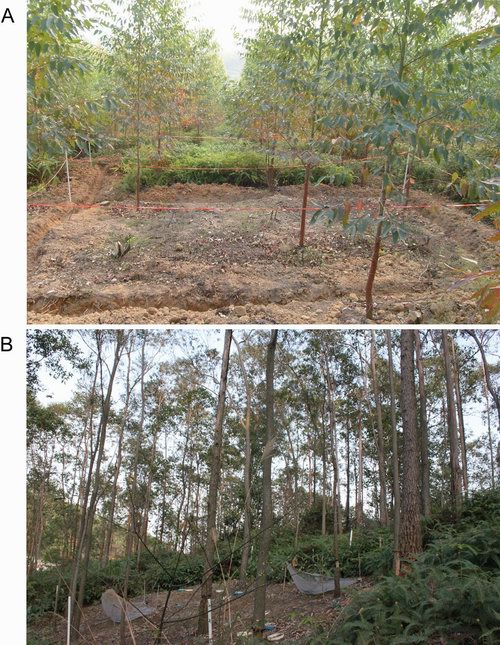Effects of Plant Functional Group Removal on Soil Microbial Community Composition and Litter Decomposition in Subtropical Eucalyptus Plantations
A key topic of ecological research involves predicting how human-induced losses of species and functional groups from real ecosystems influence ecosystem properties and functioning. When particular plant functional groups are deliberately removed from the ecosystem, it will cause apparent consequences on the ecosystem processes and functioning. Since aboveground communities and belowground communities are intimately linked and these linkages greatly affect ecosystem properties, removal of plant functional groups from aboveground communities will exert a great impact on belowground communities. However, the soil microbial community is often ignored in studies examining the effects of plant species and functional group losses on ecosystem functioning. Therefore, information concerning the influences of plant functional group losses on soil microbial community dynamics is valuable for both theoretical and management perspectives.
PhD student WU Jianping and Dr. LIU Zhanfeng from Restoration Ecology Research Group led by Professor FU shenglei at South China Botanical Garden, CAS, examined how understory removal and tree girdling influence the composition of soil microbial community and the litter decomposition in two subtropical Eucalyptus plantations. They found that understory removal significantly reduced the amount of fungal PLFAs, the ratio of fungal to bacterial PLFAs, and litter decomposition rate, but did not affect bacterial PLFAs and total PLFAs. In contrast, tree girdling did not affect the soil microbial characteristics. The changes in soil microbial community caused by understory removal were mainly attributed to the indirect effects such as increased soil temperature and soil NO3--N availability. The negligible effect of tree girdling on the soil microbial communities could be attributed to resprouting trait and mycorrhizal interactions of Eucalyptus.
This study revealed that understory plants are important components in subtropical forest ecosystems, and play different roles in maintaining soil microbial community and driving litter decomposition processes in young vs. old plantations. The functions of understory plants should be considered in forest management and restoration. This work has been online published in Functional Ecology, a leading international journal in ecology field (http://onlinelibrary.wiley.com/doi/10.1111/j.1365-2435.2011.01845.x/abstract).

Photographs of 2-year-old (A) and 24-year-old (B) Eucalyptus plantations, and associated understory vegetation in the Heshan National Field Research Station of Forest Ecosystem, Guangdong province, China. Photo credit: Liu Zhanfeng.
File Download: